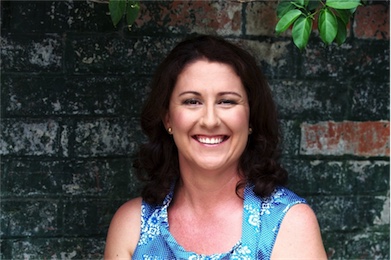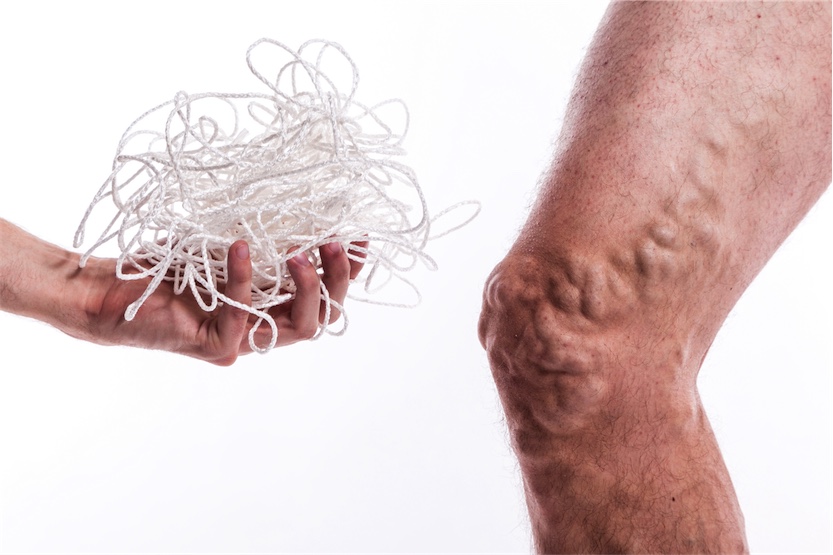Varicose veins are bulging, enlarged, twisted veins on the legs.
Factors that cause vein walls to become weakened are open to debate but a couple of the key hypothesis are:
Inflammation and varicose veins
Chronic inflammation releases proteolytic enzymes like hyaluronidase, collagenase and elastase which weaken the structure of the vein wall. A weaker wall makes them more likely to dilate. Increasing pressure on the valves causes further vein distension and pooling of blood into surrounding tissue 1.
Hormones and varicose veins
Abdominal weight gain and high insulin levels increase the conversion of androgens in the fat tissue to estrogen (estradiol). Estradiol causes the relaxation of the smooth muscle and softens collagen making them more prone to dilation 2.
This may explain the 5 times higher occurrence in female than males and the increased likelihood of developing varicose veins around menopause 3.
Pregnant women regardless of weight have higher levels of estradiol. Varicose veins may first appear in pregnancy in susceptible individuals.
Symptoms:
Aside from cosmetic changes to the legs other symptoms include itching, skin rashes and heavy aching legs that are easily fatigued.
Complications:
Varicose veins may be an early warning sign of the potential to develop more serious venous diseases including: thrombosis, skin thickening, haemorrhage and ulceration 4.
Risk factors
- Females are five times more likely than men to develop varicose veins
- Pregnancy
- Hormonal contraception and hormone replacement therapy
- Family history
- Obesity
Natural support for healthy veins
Lifestyle factors
Increase your fluids
Aim for 1 litre for each 25kg of body weight of non-alcoholic, caffeine free fluids per day. The colour of your urine is a good sign of its concentration. It should appear a light yellow, straw colour.
Reduce alcohol consumption
Alcohol contributes to inflammation and depletes two key nutrients for veins – vitamin C and zinc. Consume no more than 2 standard drinks a day for men and one for women. Have a minimum of 2 alcohol free days per week.
Maintain a healthy body weight
Being overweight puts extra pressure on your veins, making them work harder to send the blood back to your heart. This increases the pressure on the valves, making them more prone to leaking.
Move your body
Ensure regular exercise to promote venous circulation and avoid stationery standing or sitting for extended periods of time.
Consider your clothing
Avoid wearing tight fitting clothing on the upper legs that may hinder venous return. Normal venous circulation requires muscular “pumps” from the calf muscle to move the blood from the legs to the heart. In bare feet and flat shoes the walking gait relaxes and contracts this muscle. High heels, however, causes the muscle to stay contracted and venous blood flow reduces.
Reduce exposure to excess estrogen and xenoestrogens
Ensure proper metabolism of the bodies own estradiol by including plenty of cruciferous vegetables and fibre in your diet.
High levels of artificial estrogens can weaken capillary and vein walls. Consider alternatives to hormonal contraception.
Xenoestrogens can be found in certain types of plastics and skincare products. Switch to organic alternatives to reduce your exposure.
Nutrients important for vein health:
| Nutrient | Best food sources | Why it’s helpful |
| Anthocyandins |
Blueberries Blackberries Cherries |
* Repair damage to blood vessel wall, antioxidant, support healthy collagen, inhibit proteolytic enzymes |
| Rutin |
Buckwheat Figs Apples (skin on) Elderflower Tea |
* Reduce histamine release from mast cells. Histamine makes vein more “leaky” and more prone to damage. |
| Quercetin |
Apples Buckwheat Broccoli Black, Green & Oolong tea Grapes |
* Reduce spider veins * Reduce histamine release from mast cells. Histamine makes vein more “leaky” and more prone to damage. |
| Vitamin C |
Avocado Citrus fruits (include the pith) Kiwi Fruit Red capsicum Cabbage Broccoli Rosehip tea |
* Reduces free radicals and release of histamine * Supports growth of collagen to strengthen vein walls |
| Vitamin E |
Avocado Sunflower seeds Almonds |
* reduces inflammation |
| Zinc |
Seafood Grass fed red meat Pumpkin seeds |
* Strengthens vein walls |
| Herbs |
Rosemary Garlic Ginger Grapeseed Extract Horsechestnut Butcher’s Broom |
* Urosolic acid strengthens capillaries * Reduces clotting risk * Reduces clotting risk, improves circulation * Repair damage to veins, antioxidant * Reduces pain & swelling, improves blue skin colouration * Strengthens veins and reduces swelling |
| Other foods |
Asparagus Beetroot Watercress |
* Strengthens veins * Betacyanin decreases homocysteine that can damage blood vessels |
PS. These nutrients and tips are also beneficial for haemorrhoids.
References:
- Golledge J, Quigley FG. Pathogenesis of varicose veins. Eur J Vasc Endovasc Surg. 2003;25(4):319–324. doi:10.1053/ejvs.2002.1843.
- Asciutto G, MummeA., Asciutto KC, Geier B. Oestradiol levels in varicose vein blood of patients with and without pelvic vein incompetence (PVI): Diagnostic implications. Eur J Vasc Endovasc Surg. 2010;40(1):117–121. doi:10.1016/j.ejvs.2010.01.023.
- London NJ, Nash R. ABC of arterial and venous disease. Varicose veins. BMJ. 2000;320(7246):1391–4. doi:10.1136/bmj.320.7246.1391.
- Gloviczki P, Comerota AJ, Dalsing MC, et al. The care of patients with varicose veins and associated chronic venous diseases: Clinical practice guidelines of the Society for Vascular Surgery and the American Venous Forum. J Vasc Surg. 2011;53(5 SUPPL.):2S–48S. doi:10.1016/j.jvs.2011.01.079.

Need help with your health?
Norelle Hentschel is an experienced Naturopath with a clinic in Stones Corner, Brisbane who enjoys supporting her clients to reach their health goals.
Want more articles like this?
Receive a monthly digest of natural health information to help you become “health” sufficient!
PS. Your inbox real estate is precious, and we will never annoy you with sales pitches or share your details with anyone else. One email a month — that’s it.

